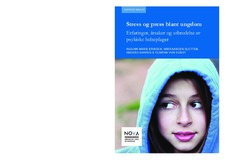| dc.description.abstract | In recent decades, there has been an increase in self-reported internalising mental health problems, such as depression and anxiety, among young people in many Western countries, including Norway. The aim of this study has been to increase knowledge about the prevalence and the reasons behind the increase in self-reported mental health problems among adolescents in Oslo, and how youths experience mental health problems. Analytically foregrounding gender, we have explored the relationship between mental health problems and pressure related to school, body image and social media use, and how demands in these different areas affect the lives of adolescent girls and boys. We have also studied how adolescents interpret questions about mental health problems asked in large surveys, and to what extent they experience that these questions address problematic issues for the youths who are affected. The report draws on mixed methods. Firstly, it is based on six focus group interviews with 29 boys and girls in tenth form, approximately 15 years old, in two different environments in Oslo. Additionally, it is based on a large survey, Ung i Oslo 2015, where questions about stress related to school, body image and social media are included. The study shows that adolescents understand symptoms of mental health problems as stress-related. Moreover, the adolescents understand the questions about mental health problems that are asked in the large surveys mainly as deeply problematic for those that are affected. They interpret most of the questions to be related to mental issues, although a question about having trouble sleeping is slightly more ambiguous, as the adolescents also relate this to staying up because of school work or social media. Primarily, the adolescents understand the questions to relate to the daily hassles and nonstop pressure from school and other arenas where they need to perform. Many also talk about a strong, but vague sense of worry and unease about the future, related to their further education and career. Both boys and girls understand stress as something that affects the body, and girls in particular talk about how stress may be painfully and intensely felt in the body, as well as affecting their thoughts and emotions. Secondly, the study demonstrates that the adolescents primarily understand the stress to originate in school. In the interviews, both girls and boys describe school-related stress as the strongest, and the quantitative analyses show that there is a close relationship between mental health problems and experienced school stress. Many girls in particular experience school-related stress. There are also many girls who experience stress related to body image, although this is more ambiguous than school pressure. Whereas the adolescents interpret school pressure as unequivocally negative, activities where they experience body pressure, such as sports and use of social media, are more mixed, as they incorporate both stress and negative emotions as well as being a source of relaxation, community and joy. | en |
| dc.description.abstract | De siste tiårene har det vært en økning i selvrapporterte psykiske helseplager, særlig blant unge jenter. Målet med rapporten har vært å få mer kunnskap om hva som ligger bak denne økningen. Ved hjelp av fokusgruppeintervjuer med ungdom og analyser av Ung i Oslo 2015 har vi utforsket sammenhenger mellom psykiske helseplager og skolepress, kroppspress og sosiale medier. Hovedfunn fra prosjektet er at ungdommene knytter symptomene på psykiske helseplager til stress, og at det er skolesituasjonen som er tettest knyttet til ungdommers stressrelaterte psykiske helseplager. Det er også mange som opplever et utseendepress, særlig jenter, og det er en relativt sterk sammenheng mellom kroppsbilde og depressive symptomer. | no_NB |
